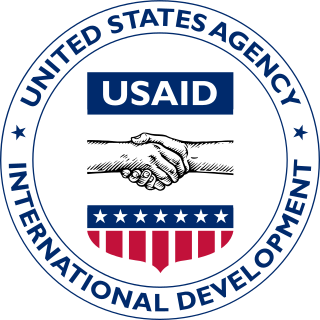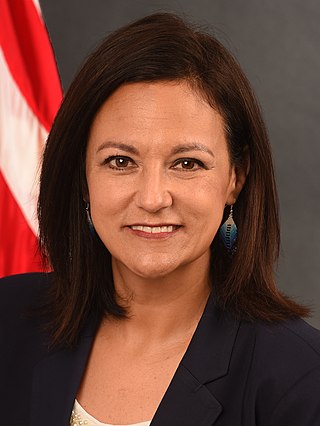Related Research Articles

The United States Department of Health and Human Services (HHS) is a cabinet-level executive branch department of the U.S. federal government created to protect the health of the U.S. people and providing essential human services. Its motto is "Improving the health, safety, and well-being of America". Before the separate federal Department of Education was created in 1979, it was called the Department of Health, Education, and Welfare (HEW).

The United States Agency for International Development (USAID) is an independent agency of the U.S. federal government that is primarily responsible for administering civilian foreign aid and development assistance. With a budget of over $27 billion, USAID is one of the largest official aid agencies in the world and accounts for more than half of all U.S. foreign assistance—the highest in the world in absolute dollar terms.

Head Start is a program of the United States Department of Health and Human Services that provides comprehensive early childhood education, health, nutrition, and parent involvement services to low-income children and families. The program's services and resources are designed to foster stable family relationships, enhance children's physical and emotional well-being, and establish an environment to develop strong cognitive skills. The transition from preschool to elementary school imposes diverse developmental challenges that include requiring the children to engage successfully with their peers outside the family network, adjust to the space of a classroom, and meet the expectations the school setting provides.
The Office of Economic Opportunity was the agency responsible for administering most of the War on Poverty programs created as part of United States President Lyndon B. Johnson's Great Society legislative agenda. It was established in 1964 as an independent agency and renamed the Community Services Administration in 1975. In 1981, it was moved into the Department of Health and Human Services as the Office of Community Services, with most of its programs continuing to operate.
The Administration for Children and Families (ACF) is a division of the United States Department of Health and Human Services (HHS). It is headed by the Assistant Secretary of Health and Human Services for Children and Families. It has a $49 billion budget for 60 programs that target children, youth and families. These programs include assistance with welfare, child support enforcement, adoption assistance, foster care, child care, and child abuse. The agency employs approximately 1,700 staff, including 1,200 federal employees and 500 contractors, where 60% are based in Washington, DC, with the remaining in regional offices located in Boston, New York City, Philadelphia, Atlanta, Chicago, Dallas, Kansas City, Denver, San Francisco, Missouri and Seattle.

The Health Resources and Services Administration (HRSA) is an agency of the U.S. Department of Health and Human Services located in North Bethesda, Maryland. It is the primary federal agency for improving access to health care services for people who are uninsured, isolated or medically vulnerable.
The Low Income Home Energy Assistance Program is a United States federal social services program first established in 1981 and funded annually through Congressional appropriations. The mission of LIHEAP is to assist low income households, particularly those with the lowest incomes that pay a high proportion of household income for home energy, primarily in meeting their immediate home energy needs. The program, part of the United States Department of Health and Human Services (HHS), is funded by grants appropriated from the federal government.
Haiti—an island country 600 miles off the coast of the U.S. state of Florida—shares the Caribbean island of Hispaniola with the Dominican Republic. Haiti has received billions in foreign assistance, yet persists as one of the poorest countries and has the lowest human development index in the Americas. There have been more than 15 natural disasters since 2001 including tropical storms, flooding, earthquakes and hurricanes. The international donor community classifies Haiti as a fragile state. Haiti is also considered a post-conflict state—one emerging from a recent coup d'état and civil war.
Federal Medical Assistance Percentages (FMAP) are the percentage rates used to determine the matching funds rate allocated annually to certain medical and social service programs in the United States of America. FMAP eligible programs are joint federal-state partnerships between the federal government of the United States and state governments, which are administered by the states. Thus, FMAP is an example of administration of federal assistance in the United States. The percentages given are the share of the total cost that the federal government will pay, the rest being covered by the state. For example, 100% FMAP for some eligible service means that the federal government pays the entire cost and 50% FMAP would mean that the cost is split evenly between the state and federal government.
CD Publications began as a news service firm located just outside Washington DC, United States. It produces Web-based "news services" whose topics of coverage include housing, health care, education, funding, aging and Native Americans.
The Maternal and Child Health Bureau (MCHB), is one of six Bureaus within the Health Resources and Services Administration, an agency of the U.S. Department of Health and Human Services located in Rockville, Maryland.

Social programs in the United States are programs designed to ensure that the basic needs of the American population are met. Federal and state social programs include cash assistance, health insurance, food assistance, housing subsidies, energy and utilities subsidies, and education and childcare assistance. Similar benefits are sometimes provided by the private sector either through policy mandates or on a voluntary basis. Employer-sponsored health insurance is an example of this.

The Older Americans Act of 1965 was the first federal level initiative aimed at providing comprehensive services for older adults. It created the National Aging Network comprising the Administration on Aging on the federal level, State Units on Aging at the state level, and Area Agencies on Aging at the local level. The network provides funding—based primarily on the percentage of an area's population 60 and older—for nutrition and supportive home and community-based services, disease prevention/health promotion services, elder rights programs, the National Family Caregiver Support Program, and the Native American Caregiver Support Program.
The Office of Child Support Enforcement (OCSE) is a United States government office responsible for overseeing the U.S. child support program. Child support is the obligation on parents to provide financial support for their children. OCSE was established with the Federal Government’s enactment of Child Support Enforcement and Paternity Establishment Program (CSE) in 1975, which was enacted to reduce welfare expenses by collecting child support from non-custodial parents.

The Wisconsin Department of Children and Families (DCF) is an agency of the Wisconsin state government responsible for providing services to assist children and families and to oversee county offices handling those services. This includes child protective services, adoption and foster care services, and juvenile justice services. It also manages the licensing and regulation of facilities involved in the foster care and day care systems, performs background investigations of child care providers, and investigates incidents of potential child abuse or neglect. It administers the Wisconsin Works (W-2) program, the child care subsidy program, child support enforcement and paternity establishment services, and programs related to the federal Temporary Assistance to Needy Families (TANF) income support program.
The Office of Refugee Resettlement (ORR) is a program of the Administration for Children and Families, an office within the United States Department of Health and Human Services, created with the passing of the United States Refugee Act of 1980. The Office of Refugee Resettlement offers support for refugees seeking safe haven within the United States, including victims of human trafficking, those seeking asylum from persecution, survivors of torture and war, and unaccompanied alien children. The mission and purpose of the Office of Refugee Resettlement is to assist in the relocation process and provide needed services to individuals granted asylum within the United States.
The Office of the Assistant Secretary for Planning and Evaluation (ASPE) is the principal advisory group to the United States Secretary of the Department of Health and Human Services (HHS) on policy development and provides coordination and support for HHS's strategic and policy planning, planning and development of legislation, program evaluation, data gathering, policy-related research, and regulatory program.
David A. Hansell is an American advocate and expert on public policy and programs that provide assistance to vulnerable populations. He started his career in public service in the late 1980s as an advocate for New York City's HIV-positive population. He then joined the City government, where he was quickly recognized for his talent for modernizing government programs, and developing innovative methods for creating economic opportunities and sustainable supports for poor and working-class families.

Jeannie Hovland is a Santee Dakota Sioux tribal member and an American government official. Hovland serves as the vice chair of the National Indian Gaming Commission and is the director of the Office of Self-Regulation. She was previously the commissioner for the Administration for Native Americans and deputy assistant secretary for Native American affairs.
Early childhood education in the United States relates to the teaching of children from birth up to the age of eight. The education services are delivered via preschools and kindergartens.
References
- ↑ "ANA Fact Sheet". Administration for Native Americans | ACF. Retrieved 2019-08-08.
- ↑ "ANA Grants". Administration for Native Americans | ACF. Retrieved 2019-08-08.
- ↑ "Social & Economic Development Strategies (SEDS)". Administration for Native Americans, Administration for Children and Families. Retrieved 2012-10-28.
- ↑ "Native Languages". Administration for Native Americans. Retrieved 2012-10-28.
- ↑ "Environmental Regulatory Enhancement". Administration for Native Americans, Administration for Children and Families. Retrieved 2012-10-28.
- ↑ "Program Areas". Administration for Native Americans | ACF. Retrieved 2019-08-08.
- ↑ "About". Administration for Native Americans | ACF. Retrieved 2019-08-08.
- ↑ "Partnerships". Administration for Native Americans | ACF. Retrieved 2019-08-08.
